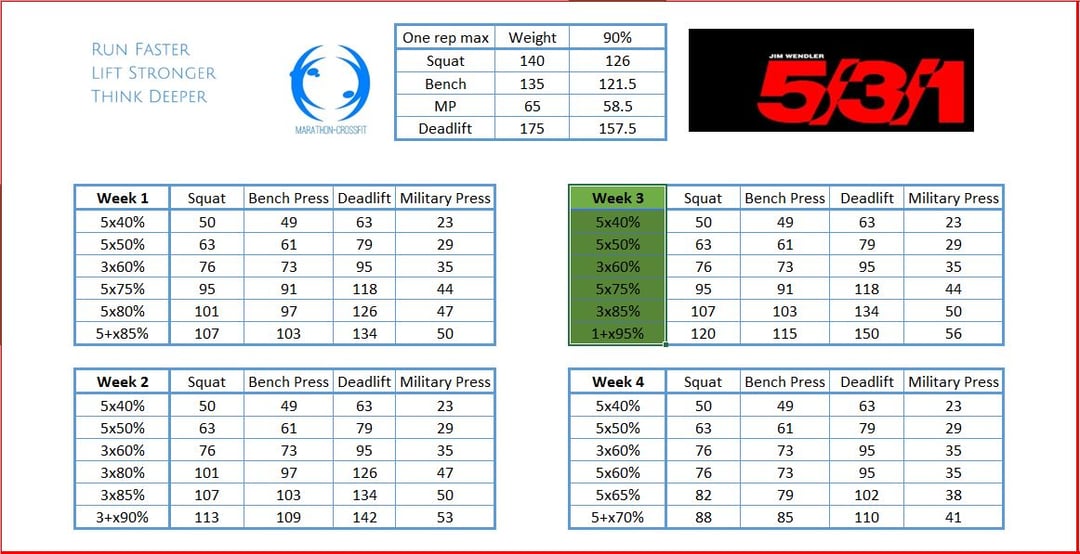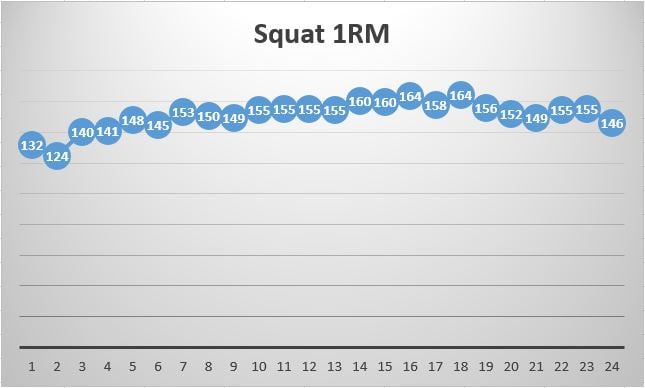Extensive 8 month wendler review
I ran the Wendler program for eight months and added 30kg to my squat, 20kg to my bench press and 20kg to my Deadlift ending at a 150kg squat, 140kg bench press and 190kg Deadlift. I recommend it for intermediate lifters, not for beginners. It is a good addition for athletes who do other sports then lifting to gain strength. It is not optimal for powerlifters who have to prepare for a meet in a year. If you have questions / comments / want to share your own experience, please leave a comment.
If you want the most up to date news or ask direct questions, then you can follow me on Instagram.
What is this lifting program?
Jim Wendler 531 is an intermediate lifting program with a cyclic approach that can be done continuously to improve performance on the bench press, Squat, Deadlift, and overhead press. It has been designed by a former high school football player and successful powerlifter Jim Wendler after combining the principles of both worlds into one program. You will find three books from Wendler, 5/3/1, Beyond 5/3/1, and 5/3/1 for powerlifting. As the core program treats everybody the same without differentiating for specific needs it is also known as a "cookie-cutter" or mass marketable program. This combined with Jim Wendler's controversial approach for marketing his program using strong language makes it a fairly popular program compared to other intermediate options in the United States.

As of April 2014, you can see that Wendler as an intermediate program has less popularity than beginner programs in terms of interest on the internet. The red curve describes the interest in the topic starting strength in red, blue Stronglifts 5x5, green Smolov, yellow Wendler 531. This is easy to grasp as in the entire world population there are more beginning lifters than intermediate lifters, as you have a certain drop out rate of beginners who never make it to intermediate lifter level for various reasons (lack of commitment, lack of time, growing up and getting a job to name a few). Smolov and Wendler are both intermediate programs, but Smolov has the advantage for being reasonable well known outside the United States and is one of the advanced options presented on the Stronglifts 5x5 webpage, which gives it a popularity boost compared to the Wendler program.
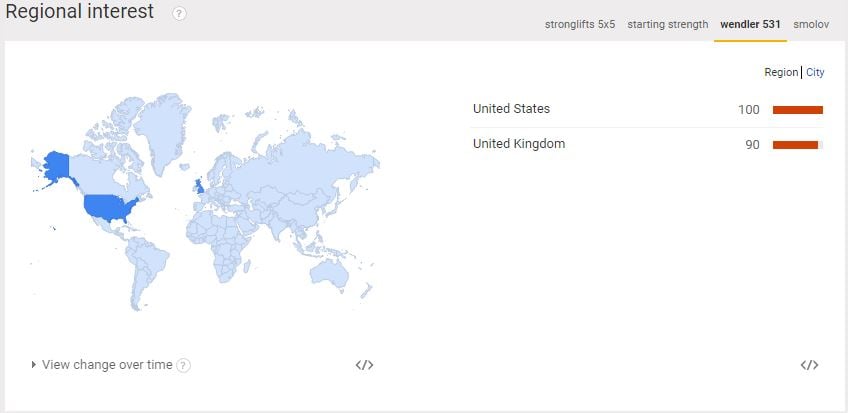
In terms of regional interest, the Jim Wendler program only seems to be known in the US and UK based on the data which Google provides. While Smolov has some traction in search in Scandinavia, 531 has nothing to show there.

If we change the scope a bit to compare like for like better and only take intermediate programs into consideration the picture looks like above. Highest interest in smolov (red line), followed by the texas method (yellow line), 531 (blue), and madcow 5x5 (green). The Texas method is the recommended follow up routine by Mark Rippetoe after doing Starting Strength (see before mentioned chart), while Smolov is one of the recommended follow-up programs by Mehdi after Stronglifts 5x5 (review of 5x5 program here) and is also described by popular strength coach Pavel Tsatsouline in his books. So in terms of popularity, I personally would describe Jim Wendler 531 as the "most popular of the lesser known intermediate lifting programs".
After checking in terms of popularity let us move on to the structure of the Jim Wendler 531 program. Wendler splits the main lifts to separate days. If done by the book you will train 4 days a week, each of these days dedicated to one of the lifts of the program. For each day, you will do six sets, three warm up, three work, with the top set (heaviest set of the day) being an "AMRAP" set. AMRAP is the abbreviation for "as many repetitions as possible". You will work with 40% to 95% of your calculated one repetition maximum. Wendler has you dial back from your real one repetition maximum by using 90% of that number for all calculations of the program. One Wendler cycle includes 4 weeks of training if you train 4 days a week. The cycle consists of a 5, 3 and one repetition week and one final deload week to set up for the next cycle. The entire outline of the program is available on the T-nation blog written by Jim Wendler himself.
First step to start with Jim Wendler is knowing your current one petition maximum for the Squat, Bench Press, Overhead press (Military press) and deadlift in pounds or kilograms depending on where you live as shown with the green highlight in the picture below. If you do not know these numbers straight out of your head, you probably should not do the program.
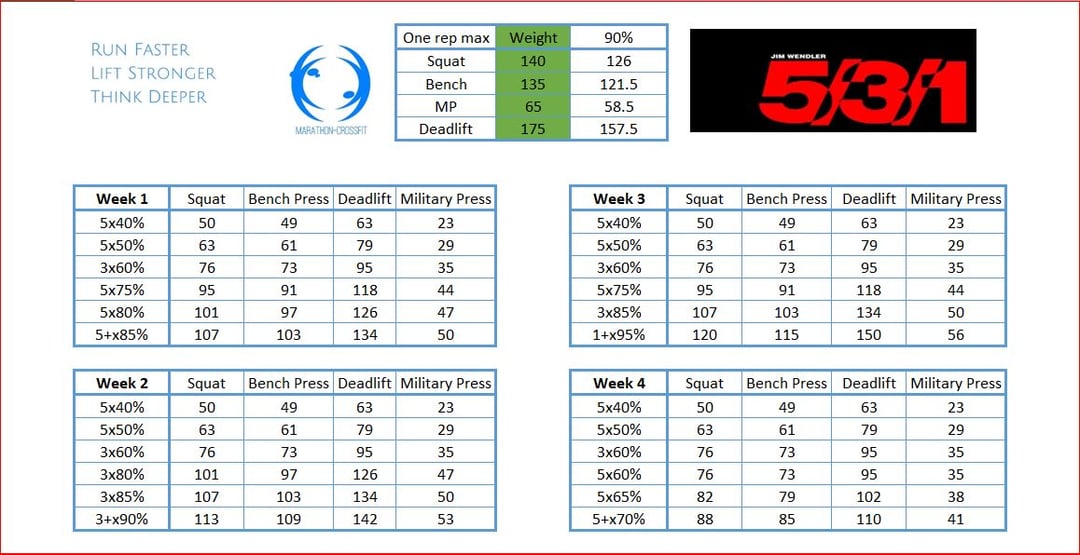
The next step is to calculate back and only take 90% of your one repetition maximum for all of the other calculations to come. There are several reasons for this. First of all many people calculate based on their lifetime one repetition maximum. Usually, this is quite off the mark when you are starting out with Wendler as the last one repetition maximum test was most likely a long time ago on an ideal date.
With the exception of powerlifters, this is a very safe way to go about picking your numbers for 531. Powerlifters might not want to do 531 as discussed on powerliftingtowin in an analysis of the program and described in Wendler 531 for powerlifters on my blog. The fact that Wendler bothered to write a third book especially addressing powerlifters might also be a hint for you that the core 531 program might not be the best pick to improve platform performance (The place where a powerlifting competition takes place is called platform).
That being said, in my opinion, the program is a very viable option for athletes. Other reasons are that dialing back the weight considerably lowers the risk of injury and lets you progress for longer before hitting a plateau.
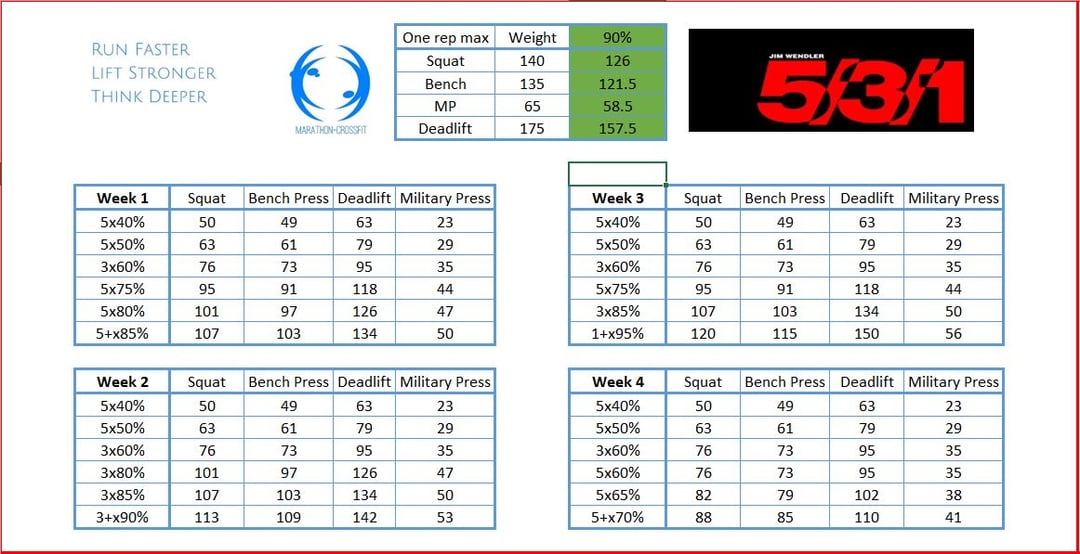
Every session should have a warm up routine with and without the bar to get the muscles firing and avoid injury. Wendler recommends the Franco Agile 8 warm up for getting ready without the bar. I like the dynamic approach of the warm up especially for your legs and lower back.
It falls a bit short in getting mobility into your shoulders especially on a bench press day, so consider to incorporate some arm circles and similar movements on that day, maybe even on all of the days, as an addition to the Agile 8 routine.
In each session, you will have three warm-up sets with the bar going from 40% to 60% of your calculated one repetition maximum. This stays the same within one Wendler cycle before the load is increased. See the picture below to get an overview. The warm up sets are highlighted in green.
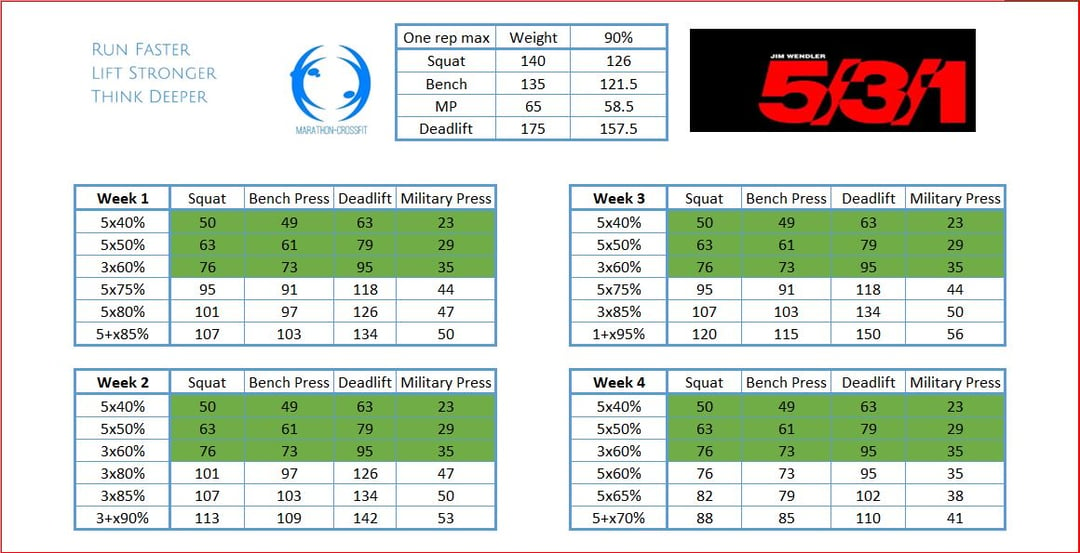
The first week of a cycle works with sets of fives to make you stronger. Sets of fives are widely used for general strength programs which appeal to the masses as they usually build strength and muscle to a similar degree. Programs with lower repetition ranges at higher load are usually more suitable for strength focused athletes which want to achieve maximum power output at the lowest weight while higher repetitions per set are usually favored by bodybuilders.
The only exception is the last set of the day which is described as a 5+, which means you should do as many repetitions as you possibly can with that weight to finish. This is one of the elements why I personally think that 531 is more suitable for intermediate lifters as it takes the experience to know which repetition on an AMRAP set is the last one before failing the next. On the 5+ week, I personally aim for ten repetitions on the AMRAP set.
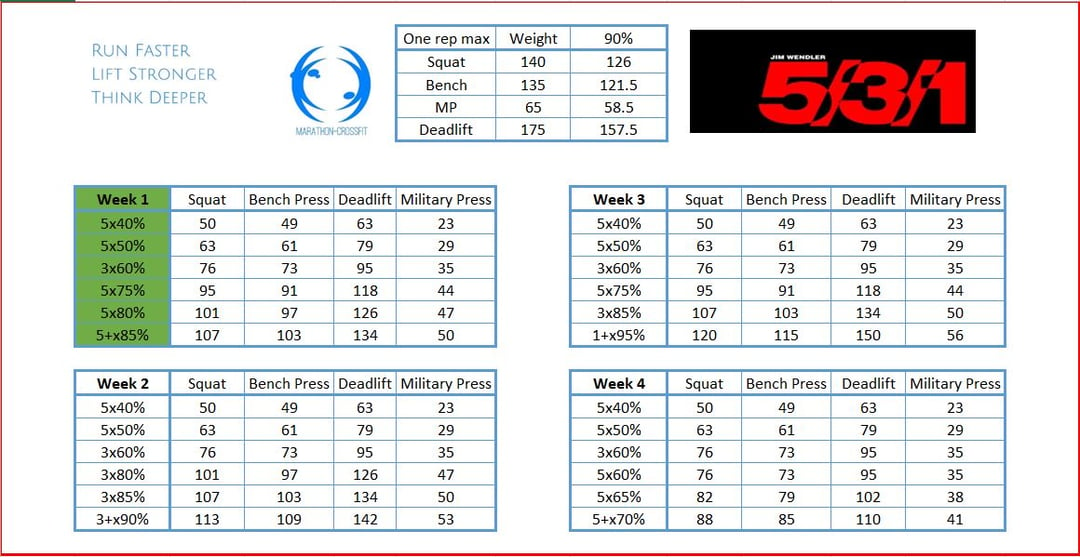
In the second week of a cycle, the load goes up by 5% compared to the previous week for each work set while the repetitions go down to three plus one AMRAP set per lift.
Working with sets of three in the 80 - 90% range is closer to optimizing for strength gains rather than muscle gains as with the sets of five. The overall tonnage moved in the second week will go down compared to the first one while you get closer to your one repetition maximum. In the 3+ week, I usually aim for up to seven repetitions on the AMRAP set.
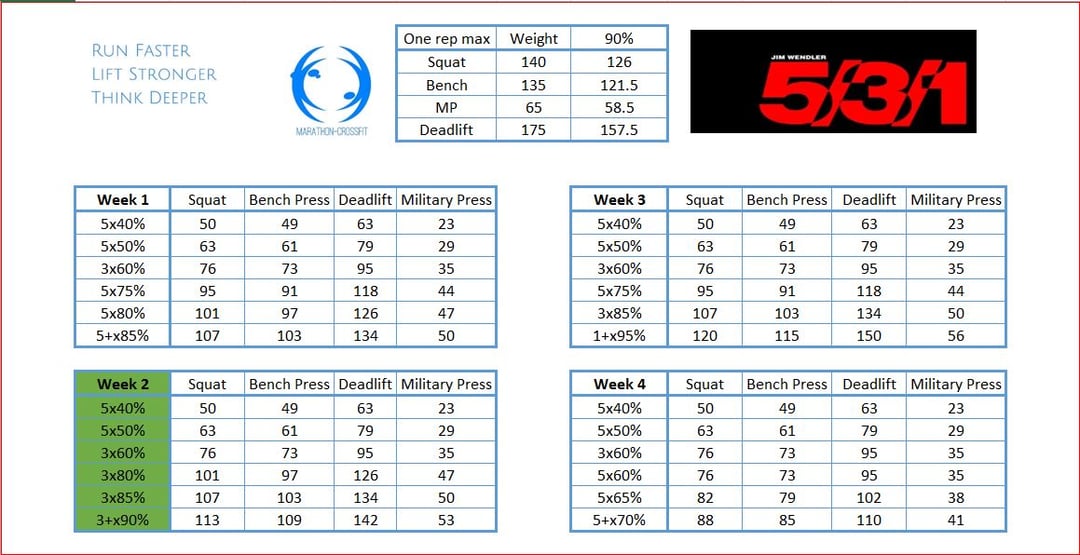
The third week of a cycle is the core piece of the Jim Wendler program in my personal opinion, combining sets of fives, threes and a AMRAP set at 95% to overload and make you stronger.
The warm up with the barbell stays the same like the two weeks before that. Then you will lift 5 x 75% 3x 85% and an AMRAP top set at 95%. This is the most interesting week in my opinion as you lift the heaviest if your main aim is strength development. See the picture below for details. For the 5/3/1 week I usually aim for five repetitions on the top set.
The last week of a Wendler cycle is a deload week to prepare you for the next cycle in which you will bring up the weights.
In this week you can relax and focus on form or speed, depending where your weaknesses are and maybe try some bodyweight / crossfit exercises. You can also take full advantage of this week and focus on mobility to get any knots out of your back and other body parts before moving on to bigger things. See the green marker for the corresponding loads on the rest week.
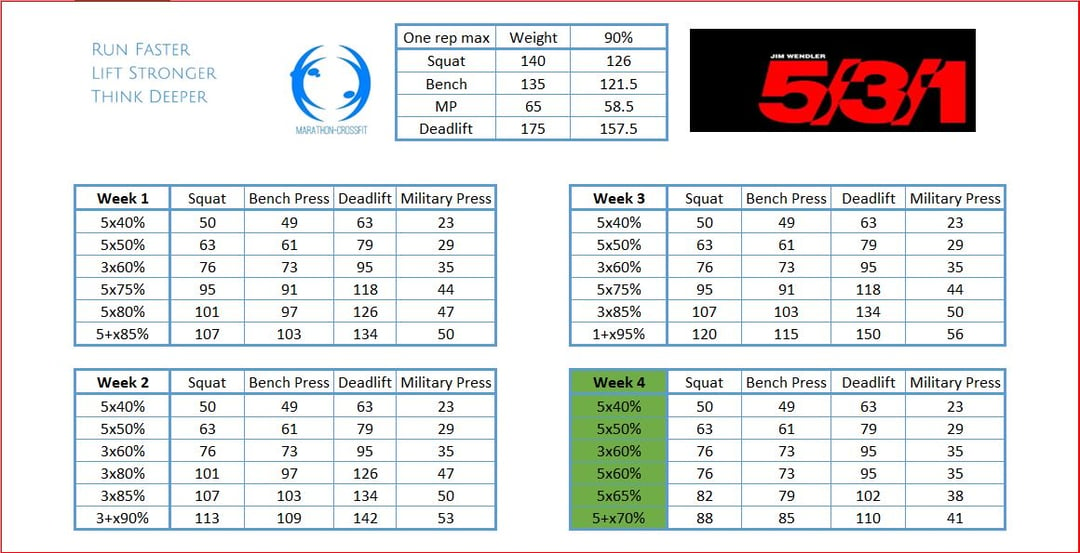
The program uses progressive overloading to make you stronger. After you concluded a cycle the whole process repeats itself with the difference that you will add 5kg to the squat and deadlift and 2.5kg to the bench press and overhead press on top of your one repetition maximum and recalculate the numbers.
This also means that the warm ups will get heavier. It can be interesting to push the envelope so far, that your work sets in the deload week for the squat and bench press are in the 100kg range. Then you have gotten very strong when you take something for a deload week that most people do not even have as a one repetition maximum. Have a look at how the numbers change below when you go up from 140kg to 145 kg on squat, 175 to 180kg on deadlift, 135 to 137.5kg on bench and 65 to 67.5kg on overhead press.
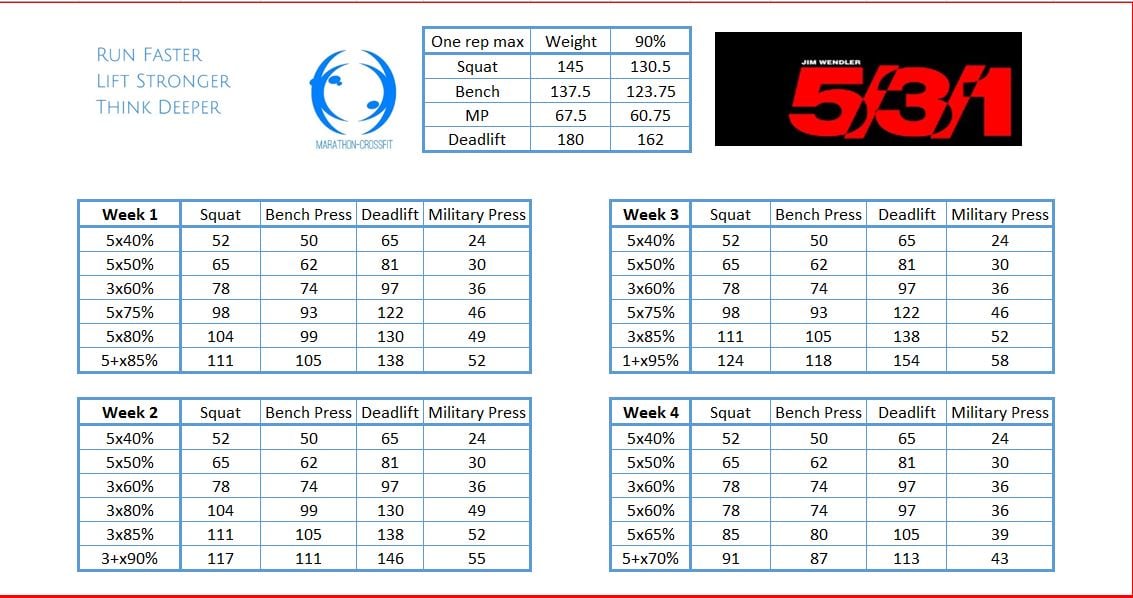
How does the program stack up in terms of overall lifting theory ?
To understand of the wendler program stacks up against the rest of the world and still not go off on too much of a digression, I will outline some basic principles around lifting and place Wendler within this overview. I will not compare specific programs. This has been and will be covered in specific articles for that purpose.
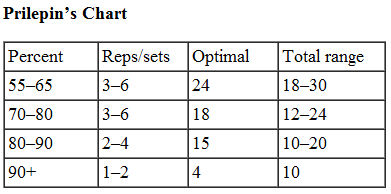
The prilepin table is a concept which helps advanced lifters to pick their repetitions and sets for a given training day. This guidance can be used and if applied to the Jim Wendler method you will work with fifteen to twenty repetitions in the first week at 75 - 85%, 9 - 14 repetitions in the 80 - 90% range in week two and and 8 - 13 repetitions in the 75 - 95% range.
In the last week you will build up to a set of 1 - 5 repetitions. As you can see Wendler's program actually stays pretty close to the Prilepin's table on the work sets. The only contrary thing to say would be that the entire program assumes 10% less of your real one repetition maximum. The prilepin table is a method of picking loads and repetitions that is commonly accepted and found its way in many strength coaching books as a rough guidance. Bottom line is that this tells you that Wendler has been generally appropriately designed to make strength gains (whether it is the fastest program to gain strength is a different discussion to be had).
There are quite a few beginner to intermediate programs out there which work with 5 sets by five repetitions for a given exercise. I personally did Stronglifts 5x5 with high satisfaction. The main difference between these and Wendler is from my perspective that Wendler usually is less aggressive on how it scales the weights and does not let you squat every day. In return, you will work with heavier loads in the third week of a cycle. I personally found that Wendler is a lot of fun to do after being on a 5x5 program for a year which can get quite dull. Be aware, though, that the core 531 cycle usually means that your overall tonnage per week goes down compared to other programs, if you do not do adjust the volume in your accessory work. If you want to compensate the lack of volume in Wendler either have a look at his publically available Buring but big template or read his beyond 531 book which adresses modifications to offset the lack of reps in the core 531 program.
When you compare Wendler to most programs which you will find on bodybuilding.com ( and they have something on anything, so please do not get out the knives out to troll me for inaccuracies just yet) it has two things which differentiate it from their programs. One is the emphasis on working with barbells and almost no dumbbell work whatsoever. You will find no Incline or decline bench presses just to mention one.
The other is that the repetition range is generally lower, as most templates on bodybuilding.com seem to work with 8 - 12 repetitions per set. Which makes sense if you look at the main focus of the website, which is building muscle. On Wendler building muscle is a side show to building strength, not the other way around. Wendler has not been build for the most mass gained in the least amount of time.
If you compare Wendler with highly complex / specific programs for a certain purpose it is relatively easy to do and to repeat. You will only have to learn four movements instead of a multitude like on sheiko. The only hurdle to overcome is to compute your loads, which can sometimes get awkward on Wendler, and have fractional plates in your local gym, which a lot of them do not, with the lowest nominator being 1.25kg. Once these points are covered, I find Wendler very easy to do.
The last category of programs I would like to mention are agressive programs like smolov or tailored approaches which have you work up to a peak at the expense of being basically f***** for a month after. These programs are ideal when you are very single-minded about a goal, like setting a new squat world / gym record or bringing your best on your yearly meet. As this only applies to a very little percentage in the population, Wendler might appeal to everyone who still want to get strong and keep working at it for a decade and do not care about specific events in the year.
What do you think of the instructions ?
Having read 531 and beyond 531 I think the instructions are fun to read and pragmatic. One of the more entertaining reads in the fitness industry I have come across so far. What the books have going for them in entertainment they lack on specifics for the instructions. If you are a person who does not want to do any research and thinking for themselves and is at a beginner's stage, the Wendler program is not for you (it also was never intended to be by the author, but I still think this should be pointed out in a review).
If you are someone who takes keen interest in the fitness industry, get sarcasm and a bit of irony, know how to work with excel and some basic principles of lifting, I think you will take great pleasure out of the instructions you get in Wendlers' blog posts and books. Just be aware that for the most advanced amongst you, you most likely will need a coach who is there with you to pinpoint your weaknesses and fix them. You can not do it yourself (you can not look at your own butt while lifting) and Wendler can not do that for you out of a book ( a book is no substitute for experienced eyes on the specific lifter during a training session).
What were your starting statistics and the results ?
I ran Stronglifts 5x5 first, then did a month of German Volume training and a month of a 10x3 rep scheme which does not have a particular name. By that stage I brought the following stats to the table for Wendler:
- Height: 185cm
- Weight 80 - 85kg depending on day
- Squat 120kg
- Bench Press 122.5kg
- Deadlift 170kg
- Overhead press 70kg
After investing 8 months and stopping the program my statistics are
- Height: 185cm
- Weight 80 - 85kg
- Squat: 150kg
- Bench Press 140kg
- Deadlift 190kg
- Overhead press 80kg
I've read in some other reviews that people see better progress and felt best with the squat on 531 and thought it was crap for the bench press and deadlift. For the deadlift in my case, I can agree as I got injured on Wendler 531 and now switched to Smolov Jr for bench for a month to give my lower back a rest.
I felt best on the program for the squat. Also the different rep schemes during the program kept it interesting until the very end, which can definitely not be said for Stronglifts 5x5. The program, while doing what it says on the tin, was not something I eagerly wanted to go back to after curing my elbow bursitis in February 2015. On the contrary to common opinion, I made very decent progress on my bench press according to my standards on the bench press.
The biggest disappointment for me is that I did not get to the 200kg deadlift which I intended as a minimum goal and also not to the 200kg squat after 12 months. This is due to stopping early and having to reset the weights one timew within the eight months. This also shows that you can not just compute progress at a desk and then expect the progressions to turn out as written in advance in the real world.
Tonnage
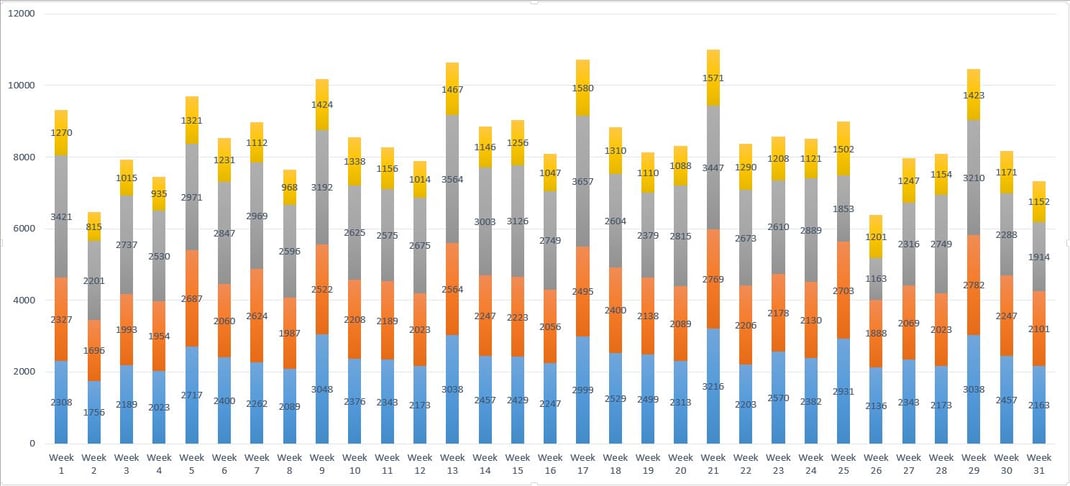
Tonnage is important when comparing different programs. The more experienced a lifter gets, the more tonnage has to be moved to create the effect of strength and muscle gains. The variables going into this are the number of sessions you do (some people tend to forget that this is the lever with the biggest impact on tonnage per week if you want to avoid overtraining), the number of sets you do in a session, the number of repetitions per set and last (and also with least impact on tonnage, a concept begtinners gladly overlook) weight which you lift per repetition.
The graph plots weight moved in kilograms on the y-axis as the sum of the sessions done in a week against time in weeks on the x-axis from the start of the Jim Wendler program in late 2015 up until finishing it in April 2016.
The graph above shows the tonnage which I have moved per week on Wendler excluding the deload weeks . Week 25 was deload after getting injured trying to push through and I stopped after one cycle where it went well (weeks 25 through 29) and then the injury returned in week 30 which lead me to stop in week 31 giving my lower back a rest.
You can overall see how 531 trends slowly but steady upwards in waves in terms of overall tonnage (weeks 1 through 24). In more aggressive programs you will see that tonnage can vary month to month quite considerably which exposes you to higher injury risk.
For the less experienced lifters amongst you maybe spent some time looking at the distribution of tonnage between the overhead press (yellow), Deadlift (grey), Bench Press (orange) and Squat (blue). I think for experienced lifters there is no news here, but if you are new to the game take a moment to let the distribution sink in as this generally will hold true for most programs as a tendency.
Normally powerlifters should pay special attention to their deadlift performance as it usually makes up about 40% of their meet total. If you are into Olympic weightlifting and wanted to change the program up to fit your needs the bench press would be the one to cut out with the least carryover. Maybe replace it with a relevant movement for the snatch like a hang snatch and / or power clean.
In my case it is quite unusual that the bench press and squat tonnage moved is that close. This is due to my particularly shit squat and over proportionately good bench press for my experience and build. Your chart will most likely look different if you run the program having the squat at a bigger distance to overall tonnage moved compared to the bench press. This is the price you have to pay if you do half squats on Stronglifts 5x5 and too much bench pressing in your teenage years, which happened in my case.
If you want to have a closer look at the graphic I recommend to open the picture only in a separate window.
One repetition maximum development
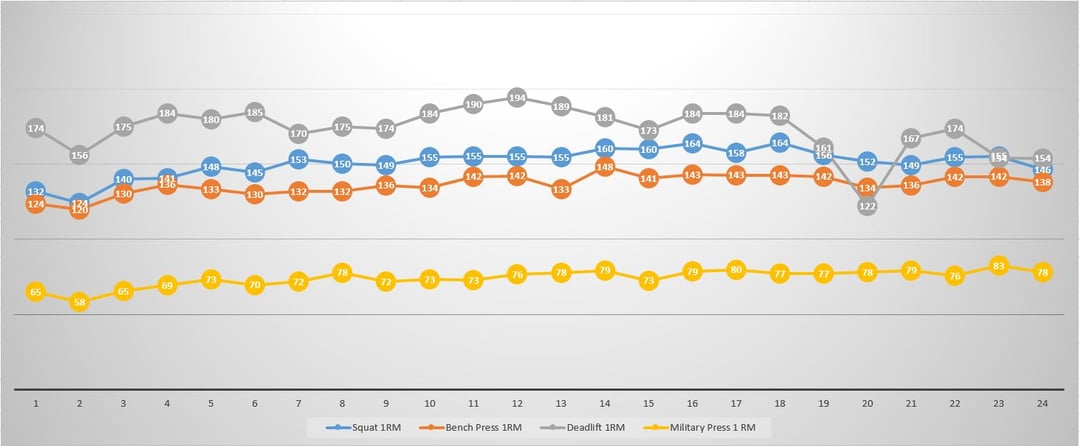
It would be a very fair assumption to make that your main interest in lifting will be based on increasing your one repetition maximum and general strength if you look at a program like Jim Wendler 531. While Tonnage is one way of looking at this, the other is to look at how your one repetition maximum is progressing.
The calculation used on Jim Wendler 531 for this is
(Number of repetitions * Weight lifted * 0.0333) + weight lifted
The chart above is the result of me tracking all the top sets on the Jim Wendler program excluding the deload weeks. For all the alert readers out there, this is what makes the difference between the tonnage and one repetition maximum chart in terms of count of weeks.
Tracking your top set development comes highly recommended by Jim Wendler and i agree with that approach to stay focused in the gym. If you have a calculator you know how you can beat your last best on a given day and whether you had a good or bad day.
For all of this, I capped my top set in a 5 repetition week at 10, in a three repetition week at 7 and in a one repetition week at 5. This also might have skewed some results, where they could have been better due to pressing out 1 - 2 reps more.
In the above chart, you see my progress on the deadlift (grey), squat (blue), bench press (orange) and overhead press (yellow) 1RM.
What you see her is that the trend of all lines is up and to the right, but the trend is not very steep. The only exception is the Deadlift with the big drop in week 20 in which I injured myself. So for me, the 531 program worked in creating more strength for my one repetition maximum. While the deadlift mirrors the waves of the tonnage lifted, the bench press, squat, and overhead press seem to climb more linear. This can be due to the fact that I worked closer to the limit for the deadlift than for the other lifts which left me with more fluctuation. The injury resulting from deadlifting is also a further point to prove that hunch of being closer to the limit for that lift.
I am most satisfied with the progress on the squat on the program. When I hit my 150kg PR it went up easy and there was room for more in my opinion which the chart also reflects hitting a calculated maximum of 164kg. Really liked doing squats on the Wendler program.
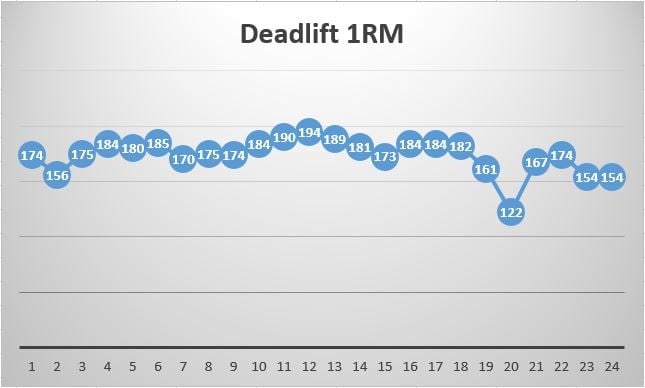
The Deadlift also progressed nicely, but not as quick as I had hoped. I expected that if I gained about 20kg on my squat I would also gain about 30kg on my deadlift to make the 200kg mark. While my calculated one repetition maximum got quite close to that I still have to lift the weight. Still delighted to have made it pass the 180kg mark (which means 4x20kg on each side of the bar.)
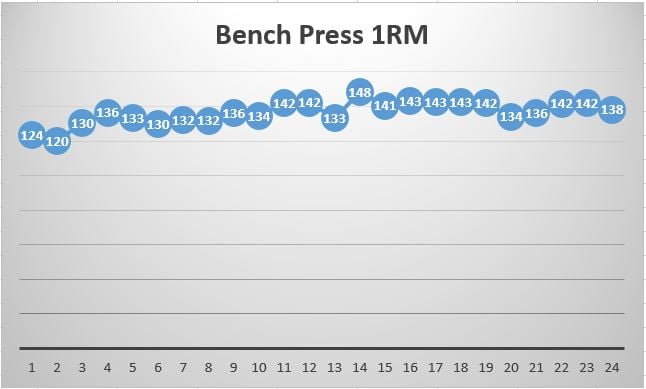
The bench press progress is solid, as I am also coming in on a higher level here. Nothing outrageous, but I am ok with that as I was satisfied with my bench walking into the program and just wanted to maintain rather than improve my number here.
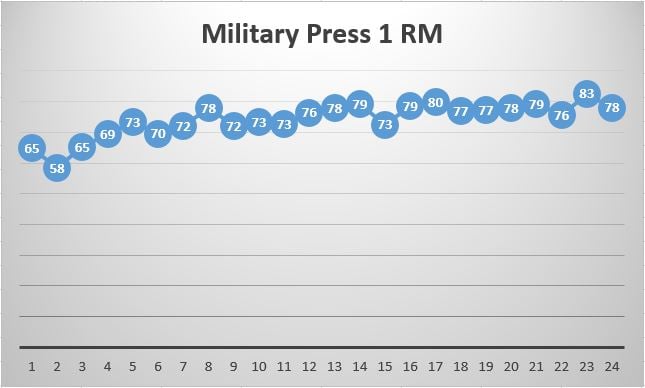
For the military press, I assumed a very low one repetition maximum to start with at 65kg. This is why this curve is a lot steeper than the others. Here I might have been better off starting more aggressive and testing my actual one repetition maximum before picking my numbers.
How often do you have to do it ?
If you want one cycle to be a month long, which I personally find quite handy, you will train four times a week. You can do less or more, but remember that in the first case you will need longer to make progress on a program that is already quite slow in showing results and for the latter you might be overdoing it and injuring yourself.
How much equipment do you need ?
I would recommend the following equipment for doing the Wendler program:
- Lifting Belt
- Lifting shoes
- Fractional plates
Especially the last item is usually not available in commercial gyms. This is why I switched my gym to a more strength focused gym for athletes with equipment like a glute ham raise bench and similar goodies. As you will be an intermediate lifter already, you usually should already have the shoes and belt.
How much time do you need ?
Without accessory work, you will be done in 30 minutes per session. Even when you progress further on the program ( not like SL 5x5 which can take up to 1.5 hours in the final stages). This makes it a very attractive option for athletes and martial artists who want a quick and effective program to gain strength.
What are the major advantages of 531 ?
The major advantages of the program are:
- Lower risk of injury compared to other programs
- Good long term gains if done correctly and you do not get greedy
- Not as boring as other programs
The minimum time effort for continuous strength gains makes this program very attractive in my opinion. I think a coach of any sports team would be well advised to know the Wendler template and apply it to their athletes where necessary.
What are the major disadvantages of the program ?
The major disadvantages of the program are:
- Calculations can be complex
- Little short term gains
- Needs fractional plates to be done correctly
- Accessory work has to be chosen by yourself
All in all this makes it a program for individuals who already have some experience in lifting. This group usually does not shy away from a little bit of calculating, has fraction plates available and know their goals and which accessory work is most suitable to obtain these.
How long will you make gains ?
That depends on how long you will run the program. I personally find that most programs are sustainable for a maximum run of a year. After then lifters get annoyed, injured or stall. I personally made good progress on Wendler for seven months until I got injured.
What did you do nutrition wise ?
No special diet, just the normal food I eat. I found that diet is important, but you can also make gains without killing yourself over the whole diet question. A shake here and there, but nothing structured.
Why did you change the program ?
Lower back pain. Needed a rest from deadlifts.
Would you recommend Jim Wendler 5/3/1 to a friend ?
No, because all of my friends should do a different beginner program first. If I had friends who are beyond the beginner stage I would definitely recommend it.
What would you recommend to accompany Wendler ?
If you want to gain muscle, do the boring but big program. If you are a powerlifter, the triumvirate seems to be a good option. As you have another half an hour in the gym you can basically do what you like. If you wanted to lose weight, run.
What would you do differently if you did Wendler again ?
I would not change the program to speed it up. I think that contributed to my injury.
Further reading
- Avoid the biggest mistakes with Jim Wendler 531
- German Volume Training vs Jim Wendler 531
Explanation for the Jim Wendler 531 calculator- How to combine Jim Wendler 531 and the westside method
- Jim Wendler 531 Joker vs Volume Sets
- Jim Wendler 531 Bodyweight Accessory work
- Jim Wendler diet
- My second Jim Wendler 531 cycle
- Wendler 531 6 month review
- Wendler 531 for athletes
- Wendler 531 for beginners
- Wendler 531 for
crossfit - Wendler 531 for mass
- Wendler 531 for
mma - Wendler 531 should you train to failure
- Wendler 531 speed up techniques
- Wendler 531 vs Stronglifts 5x5
- Which Wendler 531 book should I read



